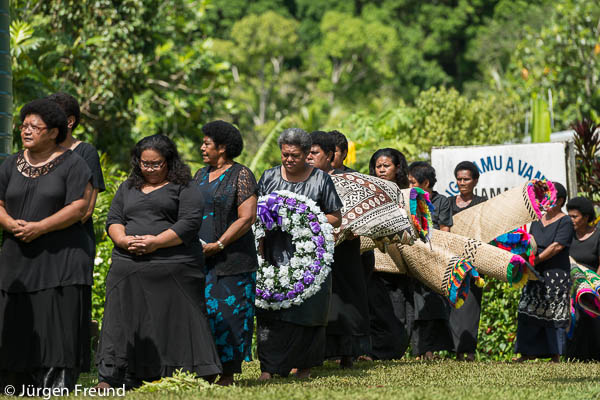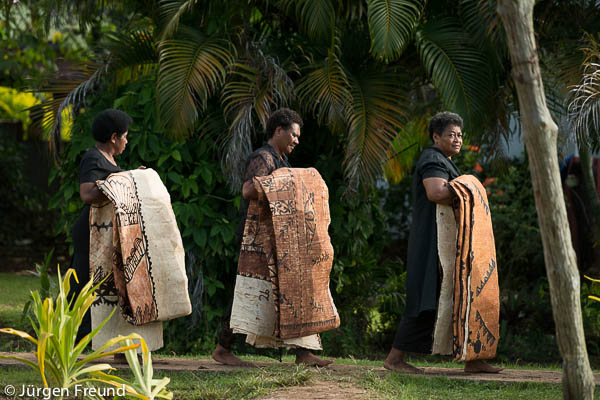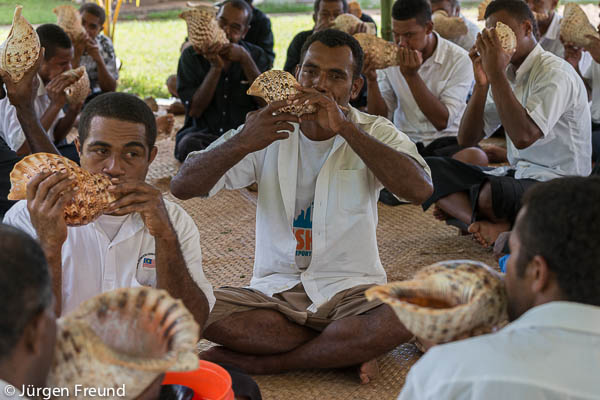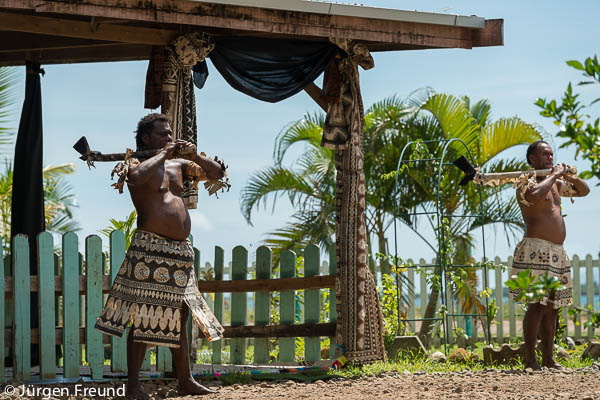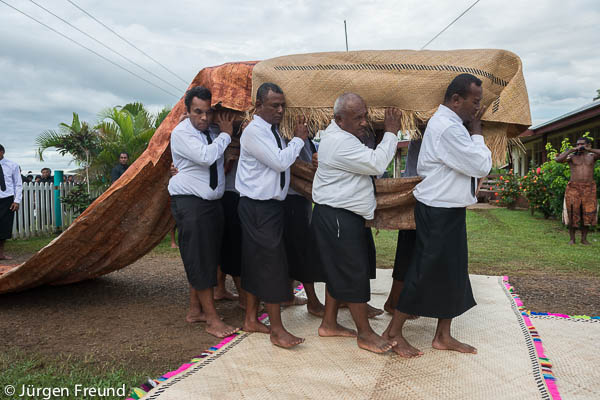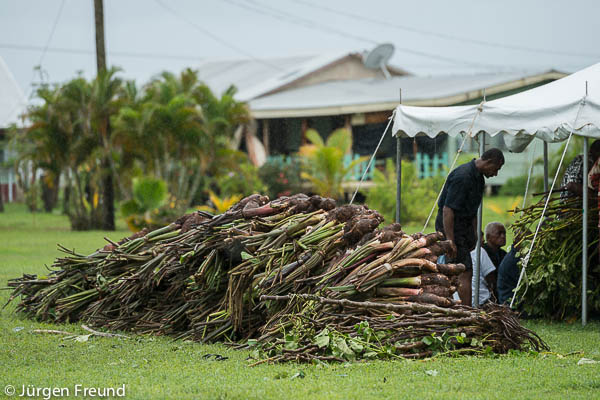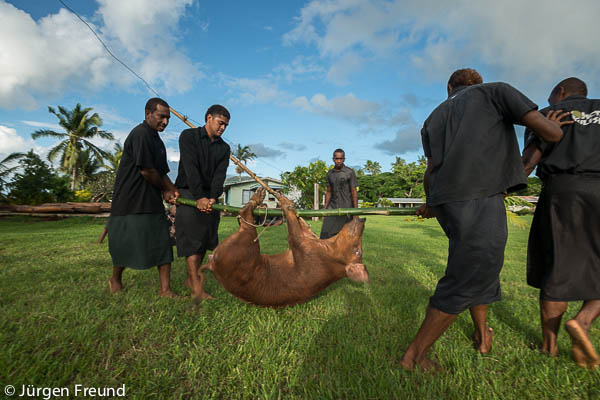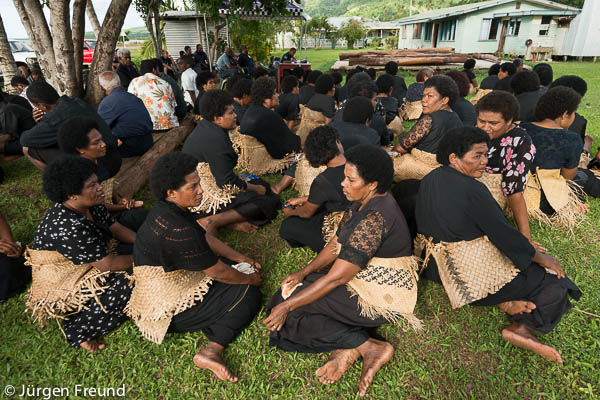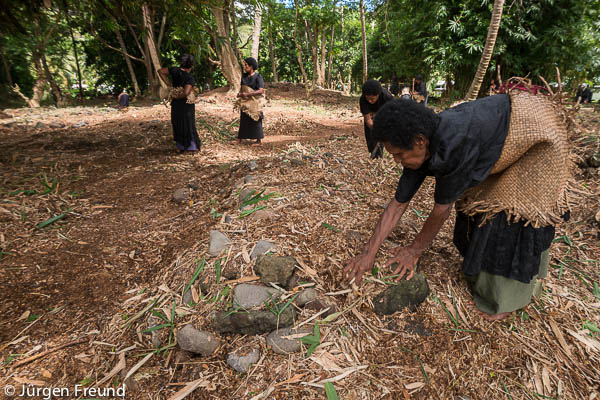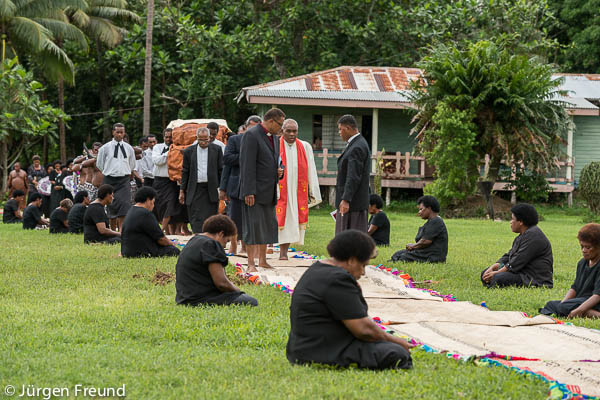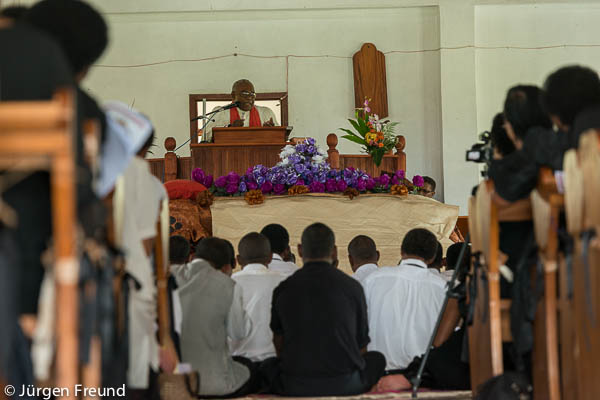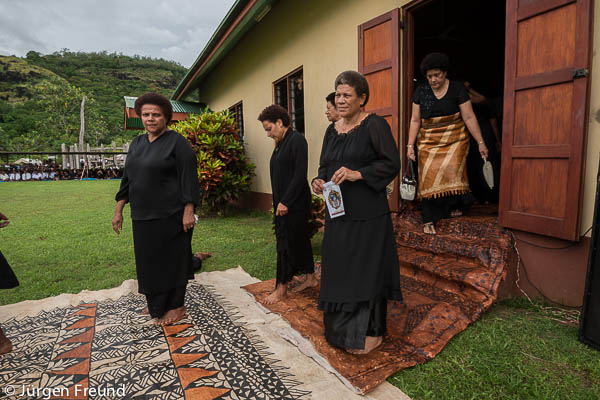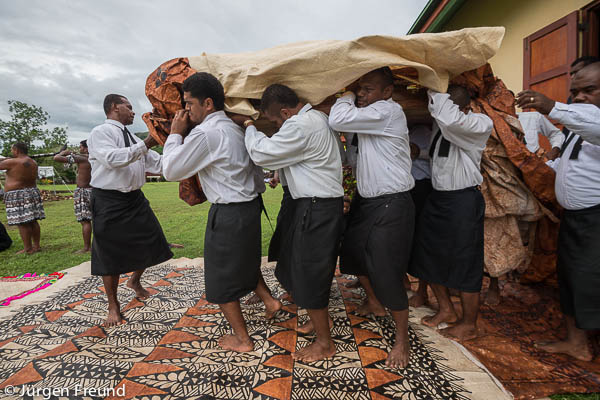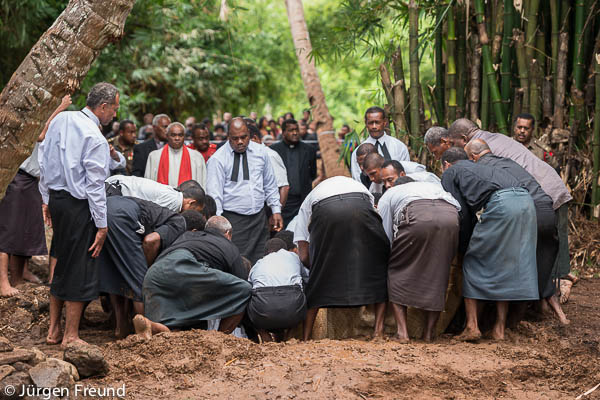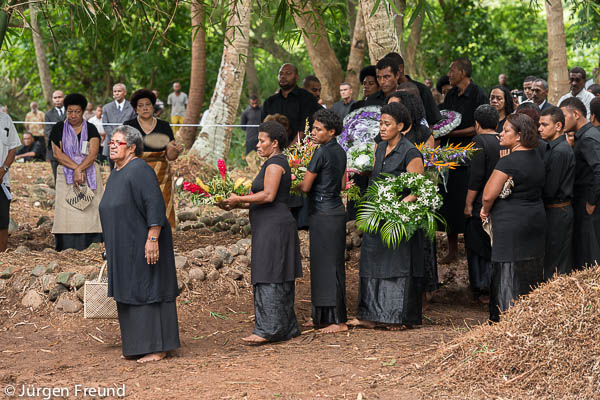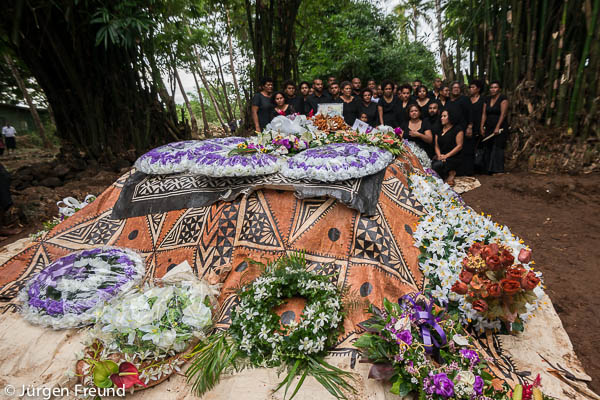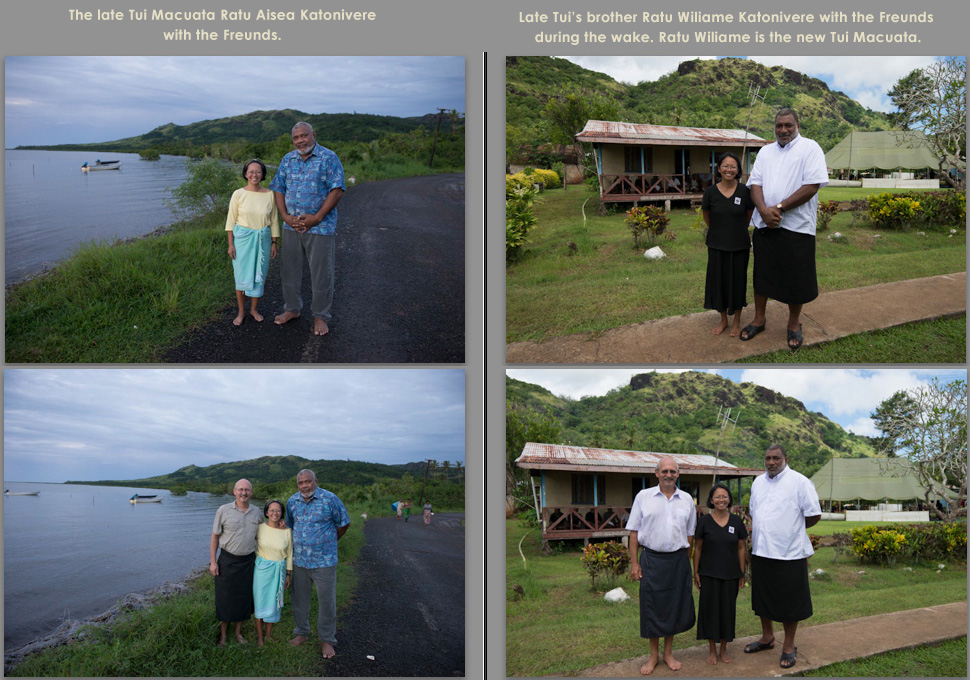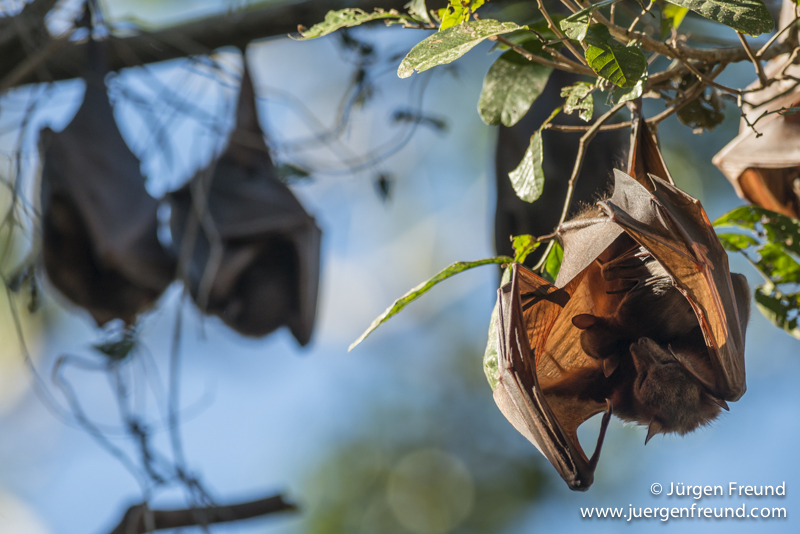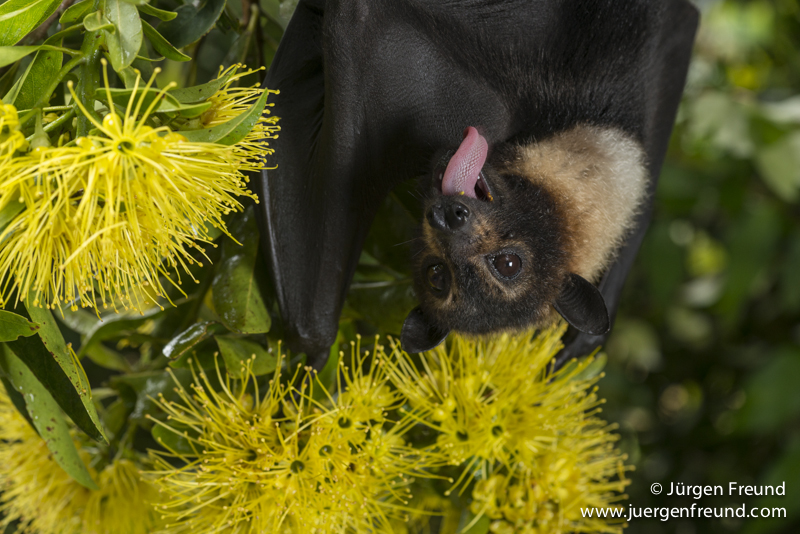25 – 27 April 2013 – Naduri, Vanua Levu, Fiji
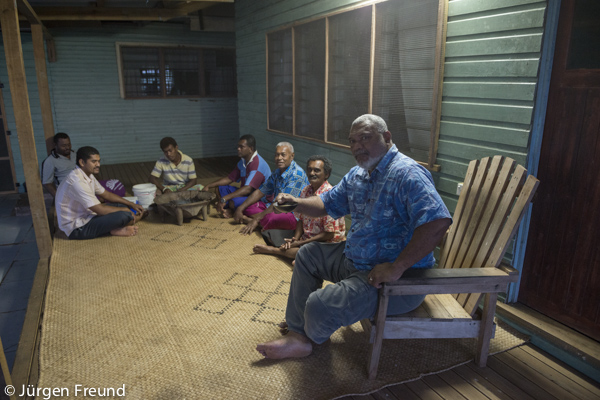
Sevusevu with the late Tui Macuata, Ratu Aisea Katonivere, Paramount Chief of Macuata Province in Vanua Levu with Koli Musudroka of WWF South Pacific.
We started our journey to Macuata Province first and foremost with a traditional sevusevu in Naduri with the Macuata Province Paramount Chief Tui Macuata Ratu Aisea Katonivere on the 28th of March. It was our very first traditional sevusevu, the first of many to come. After hearing what our noble intentions were, the big man of the province gave us his blessings to photograph his land and islands. For the whole month of April, we had an incredible journey in Macuata Province from one island to another and another, going from village to village, experiencing genuine Fijian culture, life, hospitality and generosity of spirit with every person and community we met. We felt totally privileged to be allowed into their lives that we aimed to capture the essence of what life was like in this remote Fijian land in the north.
We left Macuata Province on April 18 and headed for Yadua Island in the Bua Province. By the afternoon of April 19, we heard the alarming news from our WWF travel companion Koli Musudroka that Ratu Aisea tragically died in a fishing accident in the Great Sea Reef. The day after we left his province, the beloved Tui Macuata passed away. He was a great conservation partner of WWF South Pacific and this partnership brought about the establishment of Marine Protected Areas in the Great Sea Reef since 2004. Koli, who hails from Navakasobu, a stones throw away from the late paramount chief’s village Naduri, belongs to the Sasa Clan, the traditional Undertakers for the Ratu Aisea’s clan! He had a big job ahead of him in the coming weeks to prepare for the burial.
We recognise the privilege granted to us to be able to photograph all aspects of the 3 night and day long wake and burial – to witness Fijian living tradition unfold, to experience Fijian culture at its deepest, of seeing thousands of people pay tribute to a man who meant so much to them, to Macuata Province and to Fiji. This photo essay is our tribute to Ratu Aisea Cavunailoa Vasukinamuka Katonivere and to his family as well as to the people of Macuata Province. My deepest thanks to Adi Vilimaina Katonivere (younger sister of the late Tui Macuata) and our friend Jenny Leewai Bourke of Nukubati Island Resort for their great help and patience captioning each picture and helping me understand their rich, beautiful and complex culture.
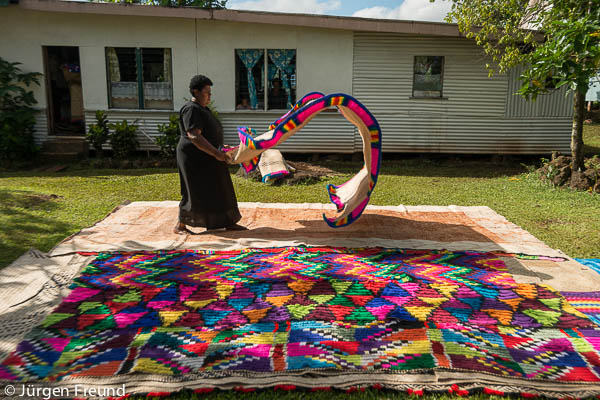
Senior women from the family of the Taukei Namara (The Kingmaker of Naduri) showing their clan folks what they have put together as their presentation or “reguregu”.
The mats and masi are part of this family’s presentation and the women will go to the mourning house. This is called the “lakolako”. The bottom mat is called the “Tatara” – the largest mat Fijians make very much like the family’s main mat carpet in their houses. The second type layer or layers onwards are the colourful mats “vakabati”. There are several of these in the Taukei Namara’s household. One is normally enough but there are at least 3 from this household. The way the “vakabati” wool or yarn is woven into the pandanus mat – it goes from at least 5 wool layers to 7, 10 and up to 30 layers. This is a lot of work. No less than 20 layers of wool is good enough for the late Tui Macuata’s position. Then the third type is a “masi” or a tapa cloth “vakamalumu”. It is as big, long and wide as the first bottom layer “Tatara” mat. On top of the masi is the “Delana” layer – another colourful one with wool that goes around the whole pandanus mat called “Kulavoki”. This is kept for very special occasions like weddings, important birthday celebrations or big funerals.
“Masi” is the most priced gift in the presentation and make up the top layer of a mat presentation. The most special mats go into the mourning house and the others go into the storage room. What mats are designated inside the mourning house are either buried with the late Tui Macuata or given to the church. All other extra mats in the storage room would later be for general distribution after the burial.

Inside the mourning house with one of the late Tui Macuata’s younger sister Adi Samanunu in the far corner and Lolohea, the lady on the left from Taukei Namara’s clan.
The appearance of the family of the President of Fiji Ratu Epeli Nailatikau is significant. His presence along with his family shows a profound gesture and honour to the late Tui Macuata.
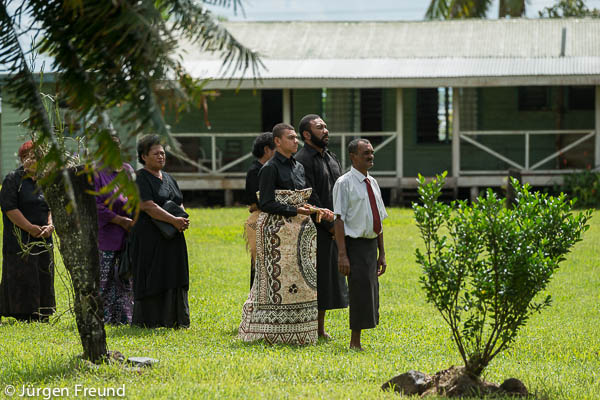
Tui Macuata’s eldest grandson Lemaki Justis Teratera Curulala in a masi wrap. He is the son of the late Tui Macuata’s eldest daughter Adi Litia Monomono Katonivere. Lemaki’s father who is beside him is from Lau and this entourage is from his father’s clan about to present their reguregu. In his tradition from Lau, they let the late Tui’s eldest grandson lead them and the masi wrap is in the Lau tradition.
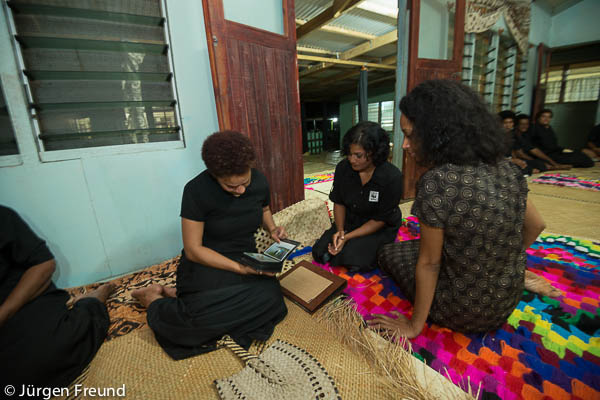
WWF South Pacific Patricia Mallam and Akisi Bolabola along with other conservation partners from Suva join in for their presentation of mats and masi to honour the late Tui Macuata during his wake in Naduri Village. Other presentation given to the late Tui’s family is a photo album made by the Freunds of pictures taken from all over Macuata Province for WWF SP. Receiving the album is the late Tui’s daughter Adi Litia Monomono Katonivere.
There were about 20-30 men (with day shifts and night shifts – 24 hours continues throughout the 4 day wake) sitting near the mourning house, each blowing a conch shell when a procession of people came for their “reguregu” presentation and to pay their respects to the family of the late Tui Macuata. Their sound was bone penetrating and heard from miles away. Before the body of Ratu Aisea arrived at the mourning house, the conch shell blowing was staccato, staggered and broken. Once the Tui Macuata’s body arrived, the blowing became continues, pretty much like moaning. When this blowing happened, it signified the end of all wailing from the house. The “davui” (the conch shell trumpet) became the sound of the “vanua” – the land and the people. The “davui” was doing all the crying so there was no longer the need for human sound. All other parts of the village were silenced as well. All crying had been symbolically carried out by the blowing of the conch shells.
The men warriors of the “Bati” clan from Raviravi Village are the warrior clan particular to Tui Macuata’s household “Bolatagane” and not Naduri – a relationship that goes back historically for many years. Here, the “Bati” clan warriors’ sole purpose in the funeral is to guard the grounds – that nobody was allowed into the funeral compound without being properly presented. They protected the house of “Bolatagane” for 24 hours all throughout the wake until the burial. They monitored the whole area and not even the immediate family of the late Tui could go around without their approval.
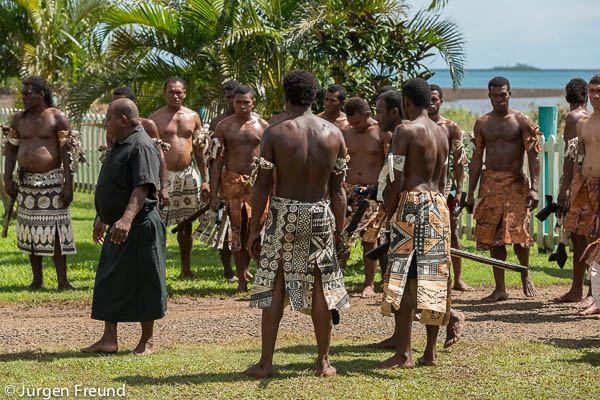
The warrior clan for the Tui Macuata’s household “Bolatagane” with Ratu Viliame Raravitu in black, leading his men warriors.
The Wasavulu Clan from Labasa took care of the Tui Macuata’s body when it was brought to the Labasa mortuary. They bathed, dressed and escorted the body from Labasa to Naduri. On Friday, the entire township of Labasa closed down at noon when the casket was taken through the main street of Labasa town. Every man, woman and child sat on the road while the casket was passing.
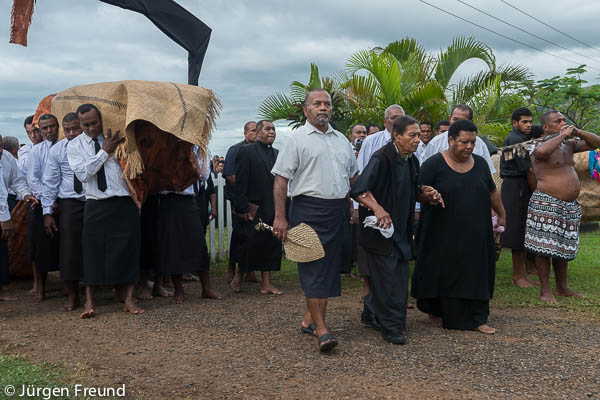
Tui Labasa Adi Salanieta Qomate arriving with the body of the Tui Macuata to hand over to Naduri. She accompanied the Tui’s body from Labasa to Naduri. Her people, her warriors guarded the Tui from the hospital in Labasa to bringing the body to Naduri. She is supported by her nephew and niece, her brother’s children. Labasa clan handed over the body and symbolically offered a “tabua” whale’s tooth which the Tui Mali received for the vanua. The Tui Labasa and the Tui Macuata go way back and have been allies for a long time.

Women and people from different parts of Macuata Province lining the Naduri roadside to farewell the late Tui Macuata as he was coming home. They came from far away to be there when the Tui’s body arrived. This location and view was what the late Tui saw when sitting in his favourite chair while he was still alive. The late Tui preferred to be in Naduri even when he had a magnificent hall in Labasa.
There was enough food to feed everyone. The food presentation of yam, pigs, turtle etc. called magiti went on for 4 days non-stop. The kitchen brigade were prepared to feed 1,000 people at any time. One lovo pit (Fijian earth oven) was fired at least 4 times a day and each lovo could feed up to 200 people. There were at least 5 lovo pits all around the compound. Villagers from Macuata Province offered two presentations of food and mats. The food cooked and served was where the significance of all the magiti presentation lies – every bit is used up to feed all.

“Lovo” pit full of volcanic rocks fired up in preparation for cooking the next batch of “dalo” or taro and pork. It takes 2 hours to fire the rocks in the pit using kindling and wood. All wood is taken out once the pit is hot enough and the raw food is placed over the hot rocks covered with breadfruit or banana leaves.
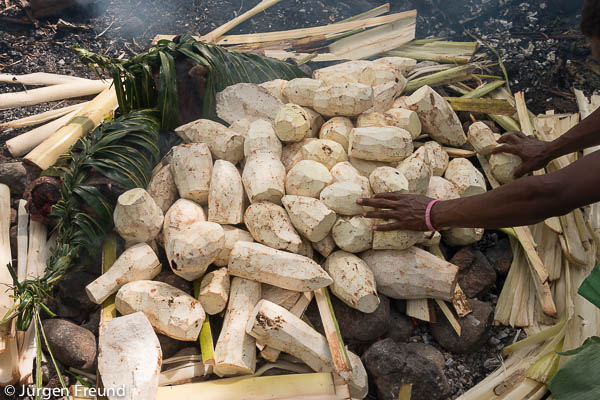
Pork and “dalo” or taro placed on the hot volcanic rocks of the “lovo”. The edges of the “lovo” are layered with banana trunks that serves to add and keep moisture inside the cooking food once it is covered. The trunks are succulent and put steam into the “lovo” to prevent the “dalo” and the pork from drying out. It is also there so the “dalo” and pork does not burn once it is covered with leaves and finally, sand. Cooking time depends on the amount of food inside but would never be less than an hour.
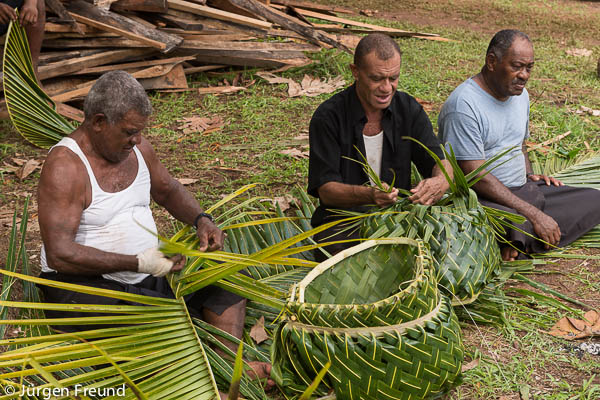
Men from different villages of Macuata Province. Their clan are designated to prepare food and considered the kitchen staff Tui Macuata’s household. These woven coconut leaves are made into baskets called “ketekete”. These are baskets for cooked food that comes hot straight from the “lovo” for serving presentation.
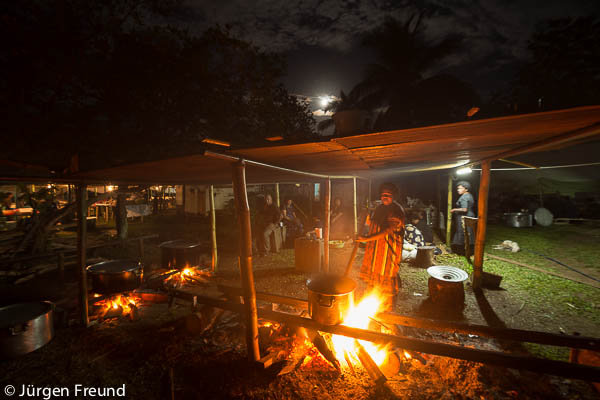
Full moon rising. Cooking army preparing the food to be served to everybody who came for their reguregu. The taro and pork are cooked in the lovo but everything else (fish turtle, beef, vegetables, etc.) gets cooked in open fire pots like this. Everybody is fed. Kitchen household catered for 4 days of the funeral, 3 days of presentation and 1 day burial.
The people of Sasa are the undertakers for the “Bolatagane” household of the Tui Macuata. They are the only ones who can touch the casket of the late Tui upon arrival in the Naduri compound. They clean the chiefly graveyard called the “Sau Tabu” where all the Tui Macuatas are buried in Naduri.
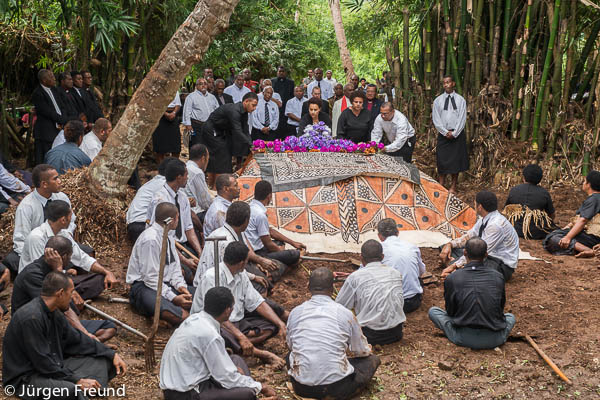
The immediate family of the late Tui Macuata placing their floral wreaths on his grave. To the left is youngest son Ratu Tevita, his daughter Adi Litia Monomono , his wife Adi Sera. This is the first time Adi Sera has been near his body as it has been the vanua who officiated the entire funeral proceedings. The family mourns in private.
And so ends our great expedition to Fiji to document the Great Sea Reef for WWF. May the great paramount chief Ratu Aisea rest in peace.
This following montage below shows us, the Freunds with the late Tui Macuata Ratu Aisea Katonivere on our first day in Macuata Province (left column). And during his wake, we stood with his brother Ratu Wiliame Katonivere, the newly installed Tui Macuata, the new Paramount Chief of Macuata Province (right column).

